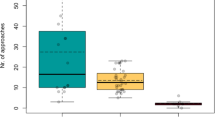Abstract
The term “habituated” is sometimes used to imply that animals no longer respond to the presence of a human observer. There is an accumulating body of evidence, however, suggesting that habituated animals that no longer perceive humans as a direct threat nevertheless continue to respond to their presence in other ways. Data were collected from a troop of free-ranging vervet monkeys in the Klein Karoo of South Africa for months 5–12 of their habituation period to determine how self-directed behaviour (SDB) was affected by human presence across time. SDB decreased across the 8 month period, indicating that habituation was ongoing. The human observer’s location in relation to the focal animal had a significant effect on SDB. Furthermore, when the habituation period was divided into an early and a late phase this pattern did not arise until the later habituation period (9–12 months). This evidence suggests that animals continue to respond to human presence as they become habituated, although the observed responses change.



Similar content being viewed by others
References
Beausoleil N, Stafford K, Mellor D (2006) Does direct human eye contact function as a warning cue for domestic sheep (Ovis aries)? J Comp Psychol 120(3):269–279
Bejder L, Samuels A, Whitehead H, Finn H, Allen S (2009) Impact assessment research: use and misuse of habituation, sensitisation and tolerance in describing wildlife responses to anthropogenic stimuli. Mar Ecol Prog Ser 395:177–185
Isbell L, Young T (1993) Human presence reduces predation in a free-ranging vervet monkey population in Kenya. Anim Behav 45(6):1233–1235
Jack K, Lenz B, Healan E, Rudman S, Schoof V, Fedigan L (2008) The effects of observer presence on the behavior of Cebus capucinus in Costa Rica. Am J Primatol 70(5):490–494
Knight J (2009) Making wildlife viewable: habituation and attraction. Soc Anim 17(2):167–184
McDougall P, Forshaw N, Barrett L, Henzi S (2010) Leaving home: responses to water depletion by vervet monkeys. J Arid Environ 74(8):924–927
Nishida T, Matsusaka T, McGrew W (2009) Emergence, propagation or disappearance of novel behavioral patterns in the habituated chimpanzees of Mahale: a review. Primates 50(1):23–36
Rasmussen D (1991) Observer influence on range use of Macaca arctoides after 14 years of observation. Lab Prim Newsl 30:6–11
Taylor A, Knight R (2003) Wildlife responses to recreation and associated visitor perceptions. Ecol Appl 13(4):951–963
Thorpe W (1963) Learning and instinct in animals. Methuen and Company, New York
Walker B, Boersma P, Wingfield J (2006) Habituation of adult Magellanic penguins to human visitation as expressed through behavior and corticosterone secretion. Conserv Biol 20(1):146–154
Webb N, Blumstein D (2005) Variation in human disturbance differentially affects predation risk assessment in western gulls. Condor 107(1):178–181
Whittaker D, Knight R (1998) Understanding wildlife responses to humans. Wildl Soc Bull 26(2):312–317
Williamson E, Feistner A (2003) Habituating primates: processes, techniques, variables and ethics. In: Setchell JM, Curtis DJ (eds) Field and laboratory methods in primatology: a practical guide. Cambridge University Press, Cambridge, pp 25–39
Acknowledgments
We are grateful to Mark and Sarah Tompkins for permission to work on their property. Dr Parry Clarke, Nicola Forshaw, April Takahashi, Nicole Whale, and David McCaffrey provided valuable assistance in the field, and many stimulating discussions. Louise Barrett provided valuable feedback on an earlier version of this manuscript. This project is funded by NSERC (Canada), NRF (South Africa), and UNISA grants to L. Barrett, S.P. Henzi, and L. Brown.
Author information
Authors and Affiliations
Corresponding author
About this article
Cite this article
McDougall, P. Is passive observation of habituated animals truly passive?. J Ethol 30, 219–223 (2012). https://doi.org/10.1007/s10164-011-0313-x
Received:
Accepted:
Published:
Issue Date:
DOI: https://doi.org/10.1007/s10164-011-0313-x




